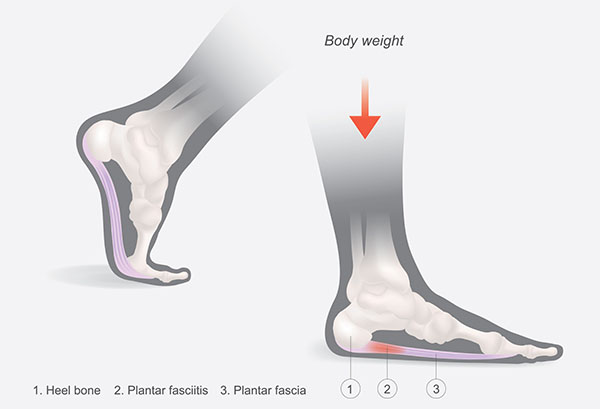Plantar Fasciitis? Can You Run With It? (Tips To Treat With Success)
Running is something that so many people are passionate about. But it can really set you back when you SUFFER from plantar fasciitis.
In this article, we’ll explain what plantar fasciitis is, how to treat it, and whether we can run with plantar fasciitis.
Plantar fasciitis has the potential to be very painful, and it can make running very difficult.
- Plantar fasciitis is a painful injury caused by foot tissue inflammation.
- Running with mild plantar fasciitis is possible with extra precautions and careful consideration.
- Treating plantar fasciitis involves stretching the tendon, using high-quality insoles, and massaging the feet.
As a runner, you likely want to deal with your plantar fasciitis injury as quickly as possible. You want to be able to get back out there and run as painlessly as possible.
While recovering from this injury, you may be tempted to keep running. Is this really going to be a good idea?
Can You Run When You Have a Plantar Fasciitis Injury?
It is possible to keep running when you have mild plantar fasciitis. You just need to be especially careful, and you should try to take extra precautions.
You will feel pain at the beginning of the run, but it usually fades as you proceed. Stop running if you have ongoing pain that doesn’t go away.
Read on to learn everything you need to know to keep yourself safe.
My Personal Experience with Plantar Fasciitis: Symptoms and Treatments
During the spring of 2021, I began to increase my running routine. As a result, the soles and heels of my feet became tender. Initially, I didn’t worry too much about the discomfort, assuming it would go away on its own.
However, one morning I woke up with an excruciating pain in my heel. Walking barefoot on the hard floor became unbearable as the pain was concentrated in my heel and sole.
I started using shoe inserts, rolled and stretched my foot, and other home remedies.
Despite trying various home treatments, I found no relief and couldn’t run for 2-3 months. Then the pain gradually subsided over six months.
Unfortunately, plantar fasciitis resurfaced after a year (milder). This time it went away in about 4 months. I hope it will not become a long-term issue.
What Does It Mean to Have Plantar Fasciitis?
When you have developed a plantar fasciitis injury, you have inflammation on the bottom of your foot.
- There is a tissue that runs from your heel to your toes.
- This tissue is a tendon that can become inflamed, and it will wind up being very painful.
- Your tendon is designed to support the arch of your foot, but it may be irritated while you are running.
One of the causes of plantar fasciitis is heel striking. This occurs when you are over-striding during a run.
When your tendon gets stretched out too far, you will experience microscopic tears. These tears will wind up causing inflammation.
Sometimes having poor arch support will make things worse, so it is always recommended to ensure that you have good running shoes to stay as safe as possible.

Trying to Run With Plantar Fasciitis
Below are some tips for managing plantar fasciitis:
Running form: To prevent further injury, consider your running form. Try not to keep your body tensed up when you are running. Keeping your legs, calves, and glutes relaxed is in your best interests.
Running shoes: Wearing proper running shoes is essential too. You never want to wear shoes that are not meant for running.
It is also best to replace sneakers before they become too worn.
You must give your feet as much support as possible to avoid further injury. Buying shoes that support your type of feet will make a big difference.
Running distance: You may want to reduce how far you are running while feeling pain.
Halving your average running distance while recovering might be a good idea. You can start to go further again once you are feeling better.
The pain will subside or become less severe over time, so it is best to try not to overdo it.
Stretching: Taking the time to stretch will also be very helpful. You should try to stretch your calves and your Achilles tendon.
When your calves are too tight, it can lead to problems with your running. It may wind up causing plantar fasciitis and will undoubtedly worsen any pain you are already experiencing.
Stretching is simple and will not take long, so stretch before running.

How to Treat Plantar Fasciitis for Runners
Fixing your plantar fasciitis issue will not happen overnight. However, you can still do some important common-sense things to help yourself feel better.
Take a look at the following tips to help runners fix plantar fasciitis.
1. Stretch Your Tendon
Stretching your tendon is going to be a good idea too.
When resting your feet too much, it might become hard to step or put weight on your feet. This is because the tendon has become overly tight and needs to be stretched out.
Thankfully, this stretching exercise is not going to be challenging to do.
You can grab your toes and pull them back toward you. Hold the stretch for ten seconds and then release. Do this several times throughout the day, and it will help stretch out your injured tendon.
You’ll be able to move around better, and it will help get you back to running sooner.
2. High-Quality Insoles Are Very Useful
Buying a high-quality insole is going to make a difference as well. The reason that you are experiencing plantar fasciitis symptoms in the first place may be due to poor arch support.
Buying an insole for your shoes that will give you the necessary support will help you to prevent this from happening again.
Insoles on the market are meant explicitly for preventing plantar fasciitis, so you should look into those.
It may be beneficial to wear inserts in all your shoes. Some runners only buy insoles for their running shoes and do not worry about their regular footwear.
It is a good idea always to give your feet the proper support. Consider buying good insoles for all of your shoes so that you can avoid having any more complications.
Our feet are different. For me, the small insoles from Soul Insole worked wonderfully. For others, a full-length insole might suit them better.
3. A Foot Massage Can Help
Simply massaging the bottom of your feet can help alleviate pain symptoms.
Some people like to massage the bottom of their feet using their own hands.
It is also possible to use special massage balls to do the job.
You can roll the ball on the bottom of your feet to give yourself a thorough massage. It helps to loosen up the tendon and can really feel very nice.
4. Use Ice to Reduce Inflammation
You can use ice to reduce inflammation, and it will also alleviate pain symptoms.
If your plantar fasciitis injury is painful, icing your feet might be worth trying. This is a simple way to help manage your symptoms.
It will allow you to get back to feeling normal more quickly. Ice your feet for up to fifteen minutes at a time and do this several times per day.
Some people even like to use water bottles instead of traditional ice packs.
You can put a water bottle in your freezer for an hour or so and then use it for your feet. Rolling the water bottle underneath your feet can feel very soothing.
Any icing method should work fine so just do whatever is the most convenient option.
Questions & Answers
How Common Is Plantar Fasciitis?
It is one of the most common causes of heel pain. While it is most prevalent in athletes, it can affect anyone.
The medical journal Annals of Internal Medicine states that in the United States, for example, this condition affects 2 million people and causes one million visits to primary care.
Studies show that up to 10% of the population suffers heel pain. Plantar fasciitis is one of the most common causes of heel pain in adults.
However, it is widespread in athletes because their fascias are more susceptible to overwork and strain.
What Are the Symptoms of Plantar Fasciitis?
The most common symptom is pain. Pain is often felt at the bottom of your foot, near the heel. It is not of the same intensity and is not located in the same place in all people.
The pain is usually most substantial during the first steps as soon as you wake up.
While on the move during the day, the pain is tolerable. In contrast, if you overdo it in exercising, you will feel pain again at the end of the day.
How Long Does Plantar Fasciitis Last?
The duration and amount of pain vary significantly from person to person. Sometimes it clears up quickly, and sometimes it takes many months.
Most of the issues will resolve within a year. Sometimes the injury becomes chronic.
In this case, the pain becomes almost constant. It can significantly impair a person’s quality of life by affecting daily activities.
Early diagnosis and treatment considerably reduce the risk of complications.
The Bottom Line
Now you know that mild plantar fasciitis can be treated or eased. You should be better prepared to keep running while suffering from mild plantar fasciitis.
If you keep the above advice in mind, you should get by without causing further problems. Ensuring that your feet have the proper support is imperative. It is also smart to know your limits.
Just try to run with the correct form and pay attention to your body’s signs. As long as you are proactive about things, you should have a good experience. You don’t have to stop running, but you must be smart.








